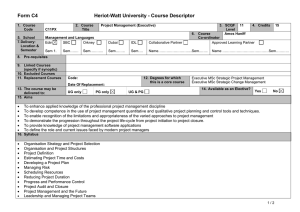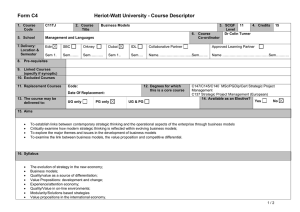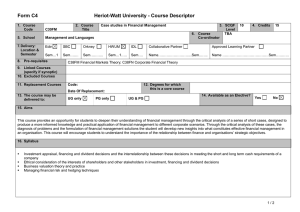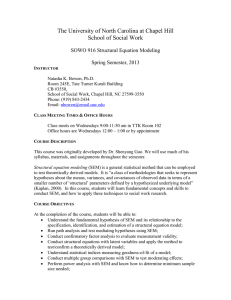The University of North Carolina at Chapel Hill Spring Semester, 2012
advertisement
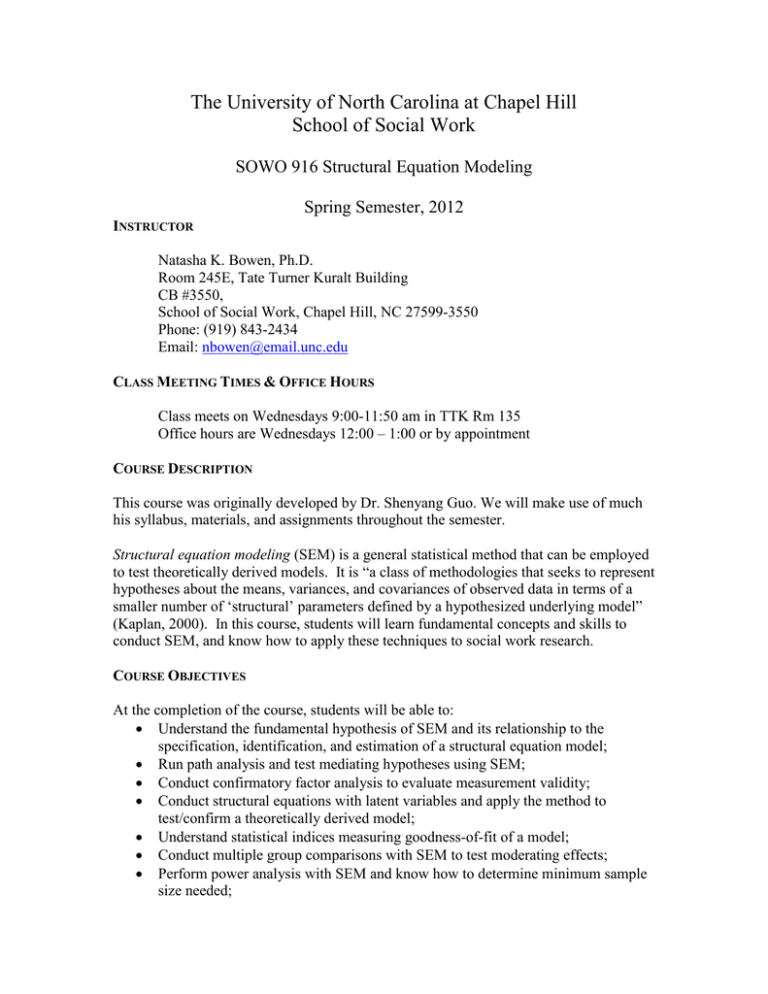
The University of North Carolina at Chapel Hill School of Social Work SOWO 916 Structural Equation Modeling Spring Semester, 2012 INSTRUCTOR Natasha K. Bowen, Ph.D. Room 245E, Tate Turner Kuralt Building CB #3550, School of Social Work, Chapel Hill, NC 27599-3550 Phone: (919) 843-2434 Email: nbowen@email.unc.edu CLASS MEETING TIMES & OFFICE HOURS Class meets on Wednesdays 9:00-11:50 am in TTK Rm 135 Office hours are Wednesdays 12:00 – 1:00 or by appointment COURSE DESCRIPTION This course was originally developed by Dr. Shenyang Guo. We will make use of much his syllabus, materials, and assignments throughout the semester. Structural equation modeling (SEM) is a general statistical method that can be employed to test theoretically derived models. It is “a class of methodologies that seeks to represent hypotheses about the means, variances, and covariances of observed data in terms of a smaller number of ‘structural’ parameters defined by a hypothesized underlying model” (Kaplan, 2000). In this course, students will learn fundamental concepts and skills to conduct SEM, and know how to apply these techniques to social work research. COURSE OBJECTIVES At the completion of the course, students will be able to: Understand the fundamental hypothesis of SEM and its relationship to the specification, identification, and estimation of a structural equation model; Run path analysis and test mediating hypotheses using SEM; Conduct confirmatory factor analysis to evaluate measurement validity; Conduct structural equations with latent variables and apply the method to test/confirm a theoretically derived model; Understand statistical indices measuring goodness-of-fit of a model; Conduct multiple group comparisons with SEM to test moderating effects; Perform power analysis with SEM and know how to determine minimum sample size needed; Understand basic concepts and skills to deal with interactions and quadratics in latent variables, and categorical variables; Understand the linkage between SEM and hierarchical linear models, and conduct multilevel analysis and latent growth curve analysis with SEM; Understand strategies dealing with missing data. PRE-REQUIREMENT Students are assumed to be familiar with descriptive and inferential statistics. A solid understanding of multiple regression analysis is a key. They should have statistical and statistical software background at least equivalent to that provided by SOWO919 (applied regression analysis and generalized linear models), SOCI209, PSYC282, EDUC284 (linear regression), or SOCI211 (categorical data analysis). SOFTWARE PACKAGES Students may choose to use SAS, SPSS, or Stata as the primary statistical software package for data management and non-SEM statistical analysis. The course will employ Mplus as the main software package for running SEM. Mplus is available through the university’s Virtual Computer Lab. Students are expected to use the Lab’s help resources to learn how to establish connections with the Lab. TEXTBOOKS Required: Bowen, N. K., & Guo, S. (2011). Structural Equation Modeling. New York, NY: Oxford University Press. Recommended: Bollen, K. A. (1989). Structural equations with latent variables. New York, NY: John Wiley & Sons. Kaplan, D. (2008). Structural Equation Modeling: Foundations and Extensions. Thousands Oaks, CA: Sage Publications. Kline, R. (2011). Principles and Practice of Structural Equation Modeling, 3rd Ed., New York: NY: Guilford Press. Long, J. Scott. (1983). Confirmatory factor analysis: A preface to LISREL. Newbury Park, NY: Sage Publications. ASSIGNMENTS Assignment 1 Assignment 2 Assignment 3 Assignment 4 Attendance and Preparation Midterm Exam Final Exam GRADE PERCENTAGE 10% 10% 10% 10% 10% 25% 25% 2 GRADING SYSTEM The standard School of Social Work interpretation of grades and numerical scores will be used. H = 94-100 P = 80-93 L = 70-79 F = 69 and below POLICY ON CLASS ATTENDANCE Class attendance is an important element of class evaluation, and you are expected to attend all scheduled sessions. Each class session will cover a great deal of material, and you will fall behind in the course when you miss even one class. It is the student’s responsibility to inform the instructor in advance for missing a class session. Starting after the second absence, your course grade will be reduced by 10% for each session missed. This reduction may make it necessary for the student to drop the course to avoid an inadequate grade. Students who miss a class are responsible for obtaining all notes, announcements, handouts, and assignments from the missed class from their fellow classmates. A grade of incomplete will only be given under extenuating circumstances and in accordance with University policy. If a student misses three classes, he or she will be expected to meet with the instructor and Associate Dean of Student Services to discuss if further participation in the course is acceptable. POLICY ON INCOMPLETE AND LATE ASSIGNMENTS Assignments are to be turned in to the instructor at the beginning of class on the due date noted in the course outline if the class meets on a due date. If assignments are sent by email, do not assume they have been received until confirmation is received. Extensions may be granted by the professor given advance notice of at least 24 hours and extenuating circumstances. Unannounced late assignments will automatically be reduced 10%. An additional 10% grade reduction will occur for each day late (including weekend days). A grade of incomplete will only be given under extenuating circumstances and in accordance with University policy. POLICY ON ACADEMIC DISHONESTY In-class activities are designed to create a collaborative learning environment. However, graded assignments are to be completed totally independently. Once an assignment has been handed out, it is assumed that students will not discuss any aspect of the assignment together—not even general principles or topics related to the assignment. Such exploring or sharing of knowledge that is even peripherally related to class assignments gives an unfair advantage to students who have peers from the same department or school enrolled in the course. Violations constitute violations of the honor code and will be treated as such. Please include the honor code statement along with your signature on all assignments: 3 “I have neither given nor received unauthorized aid on this assignment.” This statement indicates to the instructor that you did not consult with students or other human sources on any aspect of the assignment. It also represents your pledge that you have not made use of information or materials related to graded assignments from last year’s course. For assignments that are open book and take home; consulting non-human sources (text and online sources) is encouraged. For example, you may read existing SEMNET postings, articles and Powerpoints about topics that are posted online, and book chapters, but you may not post a question related to an assignment to a discussion board. All questions about assignments and these policies should be referred to the instructor. Please refer to the APA Style Guide (6th edition), the SSW Manual, and the SSW Writing Guide for information on attribution of quotes, plagiarism and appropriate use of assistance in preparing assignments. If reason exists to believe that academic dishonesty has occurred, a referral will be made to the Office of the Student Attorney General for investigation and further action as required. POLICY ON ACCOMMODATIONS FOR STUDENTS WITH DISABILITIES Students with disabilities that affect their participation in the course and who wish to have special accommodations should contact the University’s Disabilities Services and provide documentation of their disability. Disabilities Services will notify the instructor that the student has a documented disability and may require accommodations. Students should discuss the specific accommodations they require (e.g. changes in instructional format, examination format) directly with the instructor immediately after the first class session and before the second class session. Retroactive accommodations will not be implemented. The instructor is happy to make any necessary accommodations to ensure optimal learning for every student. POLICIES ON THE USE OF ELECTRONIC DEVICES IN THE CLASSROOM Students may discuss with the instructor the possibility of using laptops during class on the first day of class. Regardless of the decision made during this discussion, the use of electronic devices for non-class related activities (e.g. checking messages, playing games) is prohibited. If any such uses occur during class time, laptops will not be allowed for any students for the remainder of the course. 4 DESCRIPTION OF THE ASSIGNMENTS Homework 1: Matrix algebra, basic statistics, and expectations. Available 1/25/12; Due at the beginning of class on 2/8/12. Homework 2: Path analysis with Mplus. Available 2/8/12; Due at the beginning of class on 2/22/12. Midterm exam: Replicating a CFA study and testing an alternative factor model. Available 2/22/12; Due 3/14/12. Homework 3: Evaluating, modifying, and comparing general SEM models. Available 3/21/12; Due 4/4/12. Homework 4: Analyses with multiple groups and time points. Available 4/4/12; Due 4/18/12. Final exam: 3-hour in-class exam. 4/25/12. 5 OUTLINE OF COURSE TOPICS AND READINGS 1/11/12: Introduction to SEM and Underlying Statistics (class 1) 1. Intro to SEM 2. Begin review of basic statistics 1/18/12: Steps in SEM and more Underlying Statistics (class 2) 1. Continue Intro to SEM 2. Continue review of basic statistics 3. Expectations Required readings: Bowen & Guo Chapers 1 & 2, pp. 3-51 Hays, W. L. (1963). The algebra of expectations. Statistics for Psychologists, 3rd Edition (pp. 667-671). New York, NY: Holt, Rinehart and Winston. 1/25/12: Preliminaries (Part II): Basic matrix algebra, Data preparation (class 3) 1. Matrix operations 2. Properties of matrix operations 3. Applications of matrix algebra to statistical analysis 4. The eight basic matrices of SEM Required readings: Bollen (1989), Appendix A: Matrix Algebra Review Bowen & Guo, Chapter 3, pp. 52-72 Iacobucci, D. (2009). Everything you always wanted to know about SEM but were afraid to ask. Journal of Consumer Psychology, 19, 673-680. Homework 1 available at Sakai site, due at the beginning of class 2/8 2/1/12: Path analysis (class 4) 1. Path analysis 2. Specification, identification 3. Matrices 4. Total, direct, and indirect effects Required readings: Kline, R. (2005). Principles and practice of structural equation modeling, 2nd ed. New York, NY: Guilford Press. Chapter 5 & part of 6, pp. 93-133. Wu, Hui-ching (2011). The protective effects of resilience and hope on quality of life of the families coping with the criminal traumatisation of its [sic] members. Journal of Clinical Nursing, 20, 1906-1915. Available online at: 6 http://onlinelibrary.wiley.com/doi/10.1111/j.1365-2702.2010.03664.x/pdf 2/8/12: SEM with latent variables: Confirmatory Factor Analysis (class 5) 1. Latent variables 2. The fundamental hypothesis 3. Steps and best practices in running CFA 4. CFA matrices 5. Three types of measurement models: parallel, Tau-equivalent, congeneric Required readings (recommendation: read Hoyle, then BG, then Dimitrov): Bowen & Guo, Chapters 4, pp. 73-108 Dimitrov, D. M. (2010). Testing for factorial invariance in the context of construct validation. Measurement and Evaluation in Counseling and Development, 43, 121-149. Hoyle, R. H. (1995). The structural equation modeling approach: Basic concepts and fundamental issues. In R. H. Hoyle (Ed.), Structural equation modeling: Concepts, issues, and applications (pp. 1-15). Thousand Oaks, CA: Sage Publications. Homework 1 due at beginning of class Homework 2 available at Sakai site, due at the beginning of class 2/22 2/15/12: Confirmatory Factor Analysis: A closer look (class 6) 1. Applications 2. Second-order CFA models 3. Correlated measurement errors 4. Comparison of models (testing differences—1) Required readings: A CFA article from your area of research (Be prepared to discuss its use of best practices in CFA) Gerbing, D. W. & Anderson, J. C. (1984). On the meaning of within-factor correlated measurement errors. Journal of Consumer Research, II, 572-580. Bower, H. A., Bowen, N. K., Powers, J. D. (2011). Family-faculty trust as measured with the ESSP. Children & Schools, 33, 158-167. Werner, C. & Schermelleh-Engel. (2010). Deciding between competing models: Chi-square difference tests. Available at: http://user.uni-frankfurt.de/~cswerner/sem/chisquare_diff_en.pdf 2/22/12: General SEM: Structural and measurement models combined (class 7) 1. Steps and best practices in general SEM 2. General SEM matrices 7 Required readings: Anderson, J. C. and D. W. Gerbing (1988). Structural equation modeling in practice A review and recommended two-step approach. Psychological Bulletin 103, 411-423. Bollen, K. A. (2000). Modeling strategies: In search of the Holy Grail. Structural Equation Modeling 7, 74-81. Bowen & Guo, chapter 5, pp. 109-134. Homework 2 due at beginning of class Midterm exam distributed, due at beginning of class 3/14 2/29/12: General SEM: More on models and estimation (class 8) 1. Estimation: A closer look 2. Nonrecursive models 3. Mediation models 4. Alternative models (testing differences--2) Required readings: A general SEM article from your area of research (Be prepared to discuss the sequence of steps used to test the measurement and general models in your article) Bowen & Guo, Appendix 2, Derivation of Maximum Likelihood Estimator and Fitting Function, pp. 204-206 Ferron, J. M. and M. R. Hess (2007). Estimation in SEM: A concrete example. Journal of Educational and Behavioral Statistics, 32: 110-120. Rothbard, N. P. (2001). Enriching or depleting? The dynamics of engagement in work and family roles. Administrative Science Quarterly, 46, 655-684. 3/7/12: HAVE A GOOD SPRING BREAK! 3/14/12: Evaluating and Improving CFA and General Models (class 9) 1. Evaluating fit 2. Evaluating parameters 3. Identifying problems 4. Respecifying models Required readings: Bowen & Guo, Chapter 6, pp. 135-166 Sivo, S. A., Fan, X., Witta, E. L., & Willse, J. T. (2006). The search for "optimal" cutoff properties: Fit index criteria in structural equation modeling. The Journal of Experimental Education, 74(3), 267-288. Bring your CFA (from 2/15) and general SEM (from 2/29) articles to class Midterm due at the beginning of class 8 3/21/12: Multiple-group comparisons (class 10) 1. Measurement invariance 2. Structural path invariance 3. Comparing models (testing differences—3) Required readings: Bentler P. M. & Mooijaart, A. (1989). Choice of structural model via parsimony: A rationale based on precision. Psychological Bulletin, 106, 315-317. Bollen, K. A. (1989). Structural equations with latent variables. New York, NY: John Wiley & Sons, Comparing groups, pp. 355-369. Bowen & Guo, part of Chapter 7, 180-186 Dimitrov, D. M. (2010). Testing for factorial invariance in the context of construct validation. Measurement and Evaluation in Counseling and development, 43, 121-149. Homework 3 available at Sakai site; due at the beginning of class on 4/4 3/28/12: Longitudinal Analyses in SEM (class 11) 1. Autoregressive, cross-lagged models 2. Latent growth models Required readings: Cole, D. A. & Maxwell, S. E. (2003). Testing meditational models with longitudinal data: Questions and tips in the use of structural equation modeling. Journal of Abnormal Psychology, 112, 558-577. Curran, P. J., & Willoughby, M. T. (2003). Implications of latent trajectory models for the study of developmental psychopathology. Development and Psychopathology, 15. 581-612. 4/4/12: Power in SEM (class 12) Required readings: Bowen & Guo Chapter 7, section on power analysis, pp. 167-175 MacCallum, R.C., Browne, M.W., & Sugawara, H.M. (1996). Power analysis and determination of sample size for covariance structure modeling, Psychological Methods 1, 130-149. Homework 3 due at the beginning of class Homework 4 available; due at the beginning of class 4/18. 4/11/12: Strategies for data with problems or complexities (class 13) 1. Non-normality 9 2. 3. 4. Categorical and ordinal variables Grouped data Missing values Required readings: Bowen & Guo, reread chapter 3. It should mean a lot more to you now! Enders, C. K., & Bandalos, D. L. (2001). The relative performance of full information maximum likelihood estimation for missing data in structural equation models. Structural Equation Modeling, 8, 430-457. Flora, D. B., & Curran, P. J. (2004). An empirical evaluation of alternative methods of estimation for confirmatory factor analysis with ordinal data. Psychological Methods, 9(4), 466-491. Wegmann, K. M., Thompson, A. M., & Bowen, N. K. (2010). A confirmatory factor analysis of home environment and home social behavior data from the ESSP for Families. Social Work Research, 35, 65-128. 4/18/12: Catch Up, Review, Final Thoughts (class 14) Required readings: Bowen & Guo, Chapter 8, pp. 187-190 Optional readings (for future reference on writing about SEM analyses): Boomsa, A. (2000). Reporting analyses of covariance structures, Structural Equation Modeling 7, 461-483. Homework 4 due at the beginning of class. 4/25/12: In-class final exam (class 15) 10

